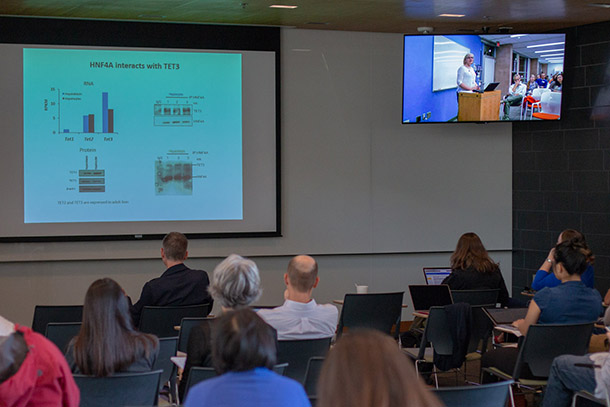It didn’t require plane tickets to bring together scientists from USC Stem Cell in Los Angeles and BCRegMed in Vancouver. During October’s Virtual Symposium, videoconferencing technology enabled these scientists to share ideas as if they were sitting in the same conference room — even though they were more than 1,200 miles apart.
During the daylong event, eight scientists from each institution gave presentations about their latest research. Dual screens in each conference room projected researchers along with their slides. During the Q&A sessions, presenters fielded questions from audiences in both locations — as well as from remote spectators following the event online.
Several presentations addressed the role of stem cells in development. USC’s Qi-Long Ying shared research about stem cell self-renewal. Pamela Hoodless from the University of British Columbia (UBC) discussed how genes are regulated during liver development. USC’s Tracy Tran and UBC’s Ido Rafaeli both presented research about a type of cell called a podocyte involved in kidney development. UBC’s Peter Zandstra described how to use mathematical models to study the competition between individual stem cells during their differentiation into various cell types. As director of UBC’s newly established School of Biomedical Engineering, a partnership between the Faculties of Applied Science and Medicine, Zandstra is leading UBC’s multi faculty and interdisciplinary initiative to bring together academia, industry and health partners around new therapeutic areas with potential transformative health impacts, including regenerative medicine.
Other talks focused on a wide variety of diseases. USC’s Joanna Smeeton and USC’s Ben Van Handel both talked about arthritis. UBC’s Mitchell Braam presented research about neonatal diabetes. USC’s Michael Bonaguidi discussed the most common form of epilepsy, and how to predict effective drugs.
Several presentations explored what happens when stem cells become malignant and cancerous. USC’s Min Yu described how circulating tumor cells can serve as a “liquid biopsy” predicting a breast cancer patient’s propensity to develop brain metastasis, and UBC’s Jennifer Grants talked about how aging and genetic changes underpin certain blood cancers. UBC’s Liam Brunham introduced a way to use stem cell-derived heart cells to test whether chemotherapy drugs might cause toxicity in certain cancer patients, but not in others. USC’s Rong Lu talked about how chemotherapy stress affects the blood stem cells in leukemia patients.
A few talks also touched on the themes of tissue engineering, as well as new technologies. USC’s Leonardo Morsut discussed how to engineer cells to form layered, embryo-like structures on command. Stephanie Willerth from the University of Victoria talked about using a 3D printer to create stem cell-derived neural tissues. UBC’s Michael Underhill discussed a new tool for identifying an important regenerative cell type, called mesenchymal progenitors.
The symposium ended with a virtual poster session: scientists presented their research as videos rather than on printed paper, and fielded questions on an online platform. The poster winners were Ksenia Gnedeva from Neil Segil’s lab at USC and Feng Xu from Jim Hogg’s lab at UBC.
“This was very successful from my point of view, and definitely something I would like to repeat at some point in the future,” said Fabio Rossi, scientific director of the BC Regenerative Medicine Initiative, and Director of Research for the School of Biomedical Engineering. “And I think it was extremely useful. I have a couple of ideas for collaborations, and hopefully they will come to fruition in the next few weeks.”
Andy McMahon, director of the Eli and Edythe Broad Center for Regenerative Medicine and Stem Cell Research at USC, added: “We hope that this is the first of many virtual symposia. Our conference room is equipped and ready to connect our scientists here at USC’s Health Sciences Campus with our colleagues across international borders, and as well as with our nearer neighbors at USC’s University Park Campus. This is an important way to foster new collaborations and accelerate scientific discovery.”
— Cristy Lytal


